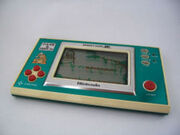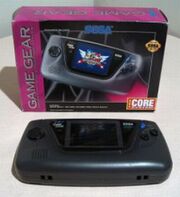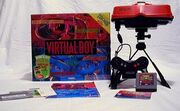Microvision (1979)

Microvision
The world's first handheld console was released in 1979 by Milton Bradley. Microvision was designed by Jay Smith, designer of the Vectrex system. Despite the system's initial success, it was gone from the market by 1981, due to the small selection of games and plethora of technical problems. Also, though it had a total of nine buttons with a different button configuration for each game, the button panel was delicate and could be damaged easily. To make things worse, the screen was really tiny, hence the name Microvision.
Game & Watch (1980)

Donkey Kong JR. (New Wide Screen), 1982 on Game & Watch
The Game & Watch series was a handheld electronic games made by Nintendo and created by its game designer Gunpei Yokoi from 1980 to 1991. Most featured a single game that could be played on an LCD screen, in addition to a clock and an alarm. Most titles had a 'GAME A' and a 'GAME B' button. Game B is usually a faster, more difficult version of game A.
Game Boy (1989)
The Game Boy was first introduced in 1989 as a pretty big, pretty plain, colorless portable game console. Four AA batteries got this puppy going for almost 20 hours of gameplay. And the only way to get stereo sound off the Game Boy was if you plugged in some headphones (only has one tiny speaker). Game Boy's software library included some of the best games of all time though like Tetris and Pokémon.
Lynx (1989)
The Lynx was a handheld game console released by Atari in 1989. The Lynx holds the distinction of being the world's first handheld electronic game with a color LCD display. The system is also notable for its forward-looking features, advanced graphics, and ambidextrous layout. The Lynx was released in 1989, the same year as Nintendo's (monochromatic) Game Boy. However, the Lynx failed to achieve the critical mass required to attract quality third party developers, and was eventually abandoned.
Game Gear (1991)

Game Gear
Work began on the console in 1989 under the codename "Project Mercury", as per Sega's policy at the time of codenaming their systems after planets. The system was released in Japan on October 6, 1990, in North America and Europe in 1991, and in Australia in 1992. The launch price was $149.99.
Over 250 titles were released worldwide for the Game Gear, although at the time of the console's launch there were only six software titles available. Sega made sure that a wide variety of video game genres were represented on the system, in order to give it a broad appeal. Prices for game cartridges initially ranged from $24.99 to $29.99 each.
Watara Supervision (1992)
The Watara Supervision is a monochrome handheld game console, originating from Hong Kong, and introduced in 1992 as a cut-price competitor for Nintendo's Game Boy. It came packaged with a game called Crystball, which is similar to Breakout.
The console has a slightly larger screen and larger buttons, and its games sold for far less than the Game Boy's. The games were simpler than the Game Boy's, and the console did not sell well. The original design for the console changed significantly through several iterations, and the last Supervisions were sold in 1996.
Virtual Boy

Virtual Boy
Nintendo's Virtual Boy was the first portable game console capable of displaying "true 3D graphics." Most video games are forced to use monocular cues to achieve the illusion of three dimensions on a two-dimensional screen, but the Virtual Boy was able to create a more accurate illusion of depth through an effect known as parallax. In a manner similar to using a head-mounted display, the user places their face inside a pair of rubber goggles on the front of the machine, and then an eyeglass-style projector allows viewing of the monochromatic (in this case, black and red) image. It was released on July 21, 1995 in Japan and August 14, 1995 in North America and at a price of around US$180. It met with a lukewarm reception that was unaffected by continued price drops. Nintendo discontinued it the following year.
